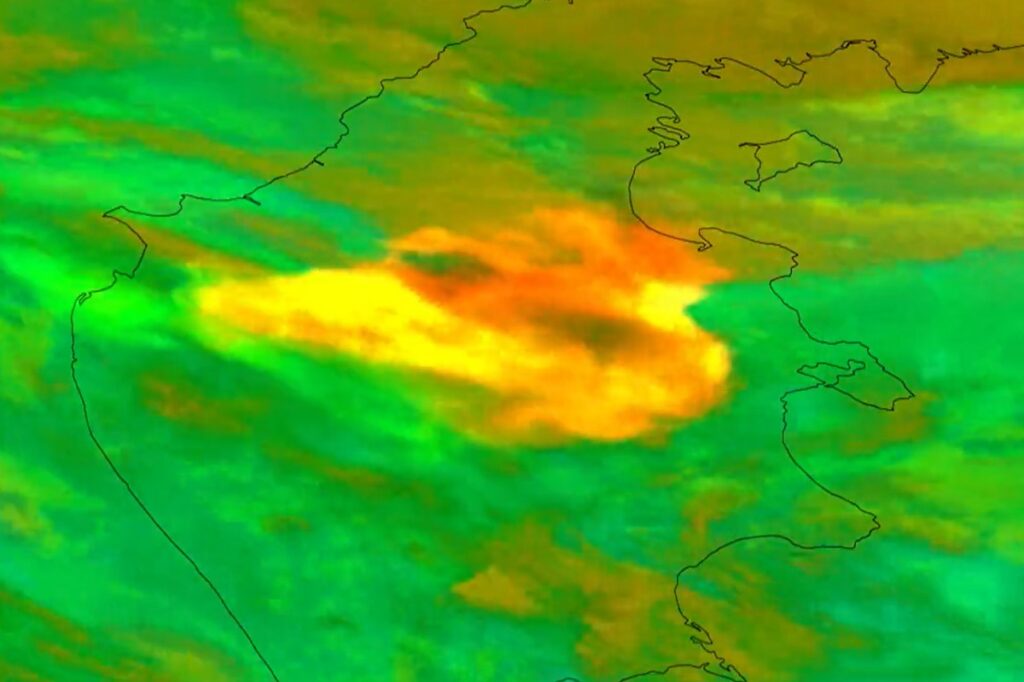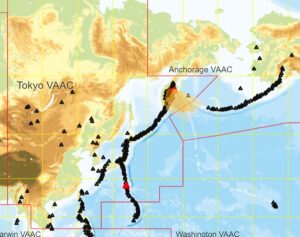
A very large and violent eruption has occurred at Shiveluch Volcano on Russia’s Kamchatka Peninsula, sending a plume of ash and gas straight into the stratosphere. Due to the presence of ash, there are impacts to trans-Pacific international flights which are being forced to re-route around the volcanic hazards. The eruption is impacting aviation interests in a busy area west of Alaska across the Bering Sea.
The Tokyo Volcanic Ash Advisory Center (VAAC), which is responsible for covering the area impacted by the ongoing eruption, continues to issue advisories warning pilots to avoid the area.
Volcanic ash can create significant harm to jet engines that fly through them or boat and automobile engines that ingest ash-filled air. Volcanic ash is hard and abrasive, and can quickly cause significant wear to various airplane parts such as propellers, turbo-compressor blades, and even cockpit windows. Because volcanic ash particles have a low melting point, it can melt in the combustion chamber of a jet engine, creating a ceramic or glass-like glaze that then sticks to turbine blades, fuel nozzles, and combustors. A jet engine that ingests just a small amount of ash could suffer from total engine failure. Overheating and engine failure is also possible in cars and trucks since volcanic ash can infiltrate nearly every opening in a vehicle. Ash is also very abrasive; ash caught between windshields and wiper blades will scratch and permanently mark the windshield glass, and windows are susceptible to scratching each time they are raised, lowered, and cleaned.
The United States, in partnership with the International Civil Aviation Organization (ICAO), operates two Volcanic Ash Advisory Centers (VAACs) within the National Oceanic and Atmospheric Administration (NOAA) where experts are responsible for coordinating and disseminating information on atmospheric volcanic ash clouds that could pose a threat to aviation. Beyond the Washington VAAC and Alaska VAAC in the U.S., other VAACs around the world, such as Tokyo’s, track volcanic debris that could impact flights elsewhere. There are nine Volcanic Ash Advisory Centers located around the world, each one focusing on a particular geographical region. Their analyses are made public in the form of volcanic ash advisories (VAAs), involving expertise analysis of satellite observations, ground and pilot observations and interpretation of ash dispersion models.
According to the Tokyo VAAC, ash and gas from Shiveluch rose up to at least 52,000 feet. Most commercial trans-Pacific aviation traffic travels at about 42,000 feet and Shiveluch is below a very busy “highway of the sky” of sorts, where most traffic to/from Asia and North America pass through on their great circle routes around the Pacific Ocean.
🌋 The mighty #Shiveluch volcano in Russia’s Kamchatka has gone full eruption mode – volcanic ash emissions has reached 20km, right into the stratosphere. #HappeningNow
Gorgeous video of the ash cloud to remind us of the beauty and the force of nature 👇 pic.twitter.com/eQ6TNgfLR1
— Russia 🇷🇺 (@Russia) April 10, 2023

The Institute of Volcanology and Seismology of the Far Eastern Branch of the Russian Academy of Sciences (RAS) said a “red” hazard designation, the highest level, had been issued for aviation and that there is a risk of hot lava flows blocking roads, Russian state news agency TASS reported.
“Molten lava flows can travel up to 20 kilometers and block the Petropavlovsk-Kamchatsky-Ust-Kamchatsky highway,” the institute said, according to TASS.
Just days ago, another significant eruption occurred on the nearby Bezymianny volcano on April 7th. Also located on the Kamchatka peninsula, that eruption activity prompted the Federal Agency for Air Transport, Rosaviatsiya, to issue a Notice to Airmen (NOTAM) and raise the aviation Color Code Red. The hazard classification is the highest on the International Civil Aviation Organization’s scale due to the active threat of volcanic activity posing a danger to domestic and international flight.